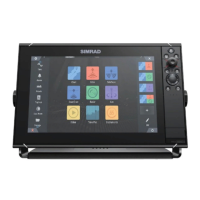Ú
Note: In order to enable group selection, the unit must be set to the Simrad group.
Devices with no selected group can use different sources than the rest of the network
devices.
Advanced source selection
This allows the most flexible and precise manual control over which devices provide data.
Occasionally auto select might not assign the desired source, which can be corrected using
the advanced source selection.
Device list
Selecting a device in this list will bring up additional details and options for the device.
All devices allow allocation of an instance number in the configure option. Set unique
instance numbers on any identical devices on the network to allow the unit to distinguish
between them. The data option shows all data being output by the device.
Ú
Note: In most cases, setting the instance number on a 3rd party product is not possible.
Diagnostics
Provides information useful for identifying an issue with the network.
NMEA 2000
Provides information on NMEA 2000-bus activity.
Ú
Note: The following information might not always indicate an issue that can be simply
resolved with minor adjustment to network layout or connected devices and their
activity on the network. However, Rx and Tx errors are most likely indicating issues with
the physical network, which can be resolved by correcting termination, reducing
backbone or drop lengths, or reducing the number of network nodes (devices).
UDB
Provides information on Ethernet activity.
SimNet groups
This function is used to control parameter settings, either globally or in groups of units. The
function is used on larger vessels where several units are connected via a network. By
assigning several units to the same group, a parameter update on one unit will have the
same effect on the rest of the group members.
If any of the settings require discrete control, set the group to None.
Damping
If data appears erratic or too sensitive, damping may be applied to make the information
appear more stable. With damping set to off, the data is presented in raw form with no
damping applied.
Calibration
An offset (positive or negative) can be applied to correct data inaccuracies from NMEA 2000
sources. The offset is set on the NMEA 2000 device.
Ú
Note: Select the advanced option to adjust local offsets for this display only.
Ú
Note: It is typically not possible to calibrate 3rd party sensors. However, a local offset can
be applied.
NMEA 2000 setup
Receive waypoint
Select this option to allow another device capable of creating and exporting waypoints via
NMEA 2000 to transfer directly to this unit.
38
System setup | NSS evo3S Installation Manual

